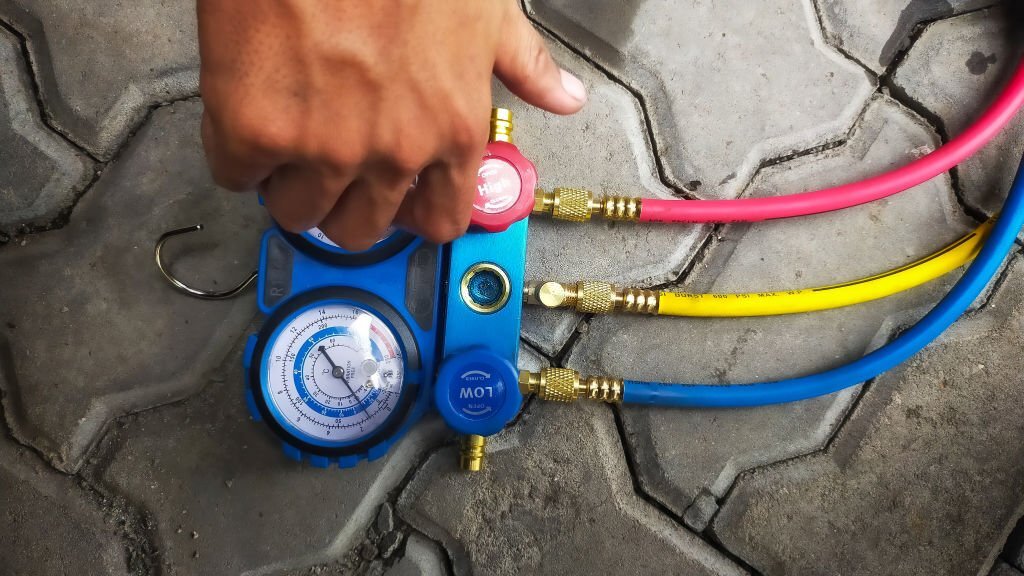R410A is a refrigerant that is found in air-conditioning and refrigeration systems. It is a low-global-warming refrigerant, which means it is less harmful to the environment than other air-conditioning and refrigeration system refrigerants.
Top 5 Things You Should Know About R410a
- Composition: R410A is a hydrofluorocarbon (HFC) refrigerant that is a blend of two HFCs, difluoromethane (R32) and pentafluoroethane (R125).
- Applications: R410A is primarily used in air conditioning and heat pump systems. It is also used in refrigeration systems, especially for residential and light commercial applications.
- Environmental impact: It has a higher global warming potential (GWP) than older refrigerants such as R22, but it does not deplete the ozone layer.
- Pressure: It operates at a much higher pressure than R22, requiring special materials in the refrigeration system, such as hoses, valves, and compressors.
- Safety: R410A is classified as mildly flammable and requires special handling and storage precautions. Technicians must be trained and equipped to handle R410A to prevent safety hazards and ensure proper system performance.
How Does It Work?
R410A works through a refrigeration cycle that involves four main components: compressor, condenser, expansion valve, and evaporator. The refrigerant evaporates in the evaporator to absorb heat from the interior space being cooled. The refrigerant then becomes pressurized and hot in the compressor and releases heat in the condenser before returning to a low-pressure, low-temperature state in the expansion valve. The refrigerant then repeats this cycle. In this process, R410A absorbs heat from the interior space and releases it outside, cooling the interior space.
The Recycling Process
Collection: The refrigerant is collected from the air conditioning or refrigeration system through a recovery machine.
Purification: The refrigerant is passed through filters and cleaners to remove impurities and contaminants.
Testing: The purified refrigerant is tested to ensure it meets industry standards for purity and quality.
Recharging: The purified refrigerant is then charged into a new or recycled container for future use.
Record keeping: Records of the refrigerant recovery, purification, and recharging process are maintained for regulatory compliance and transparency.
It’s important to note that only certified technicians should recycle R410A refrigerant, as it requires proper training and equipment to prevent safety hazards and environmental harm.
How Can R410a Be Used To Improve Indoor Air Quality?
R410A can be used to improve indoor air quality through the following methods:
Filtration: Most air conditioning and refrigeration systems using this refrigerant come equipped with air filters that remove impurities, allergens, and pollutants from the air.
Humidity control: R410A systems can control humidity levels by removing excess moisture from the air, improving indoor air quality, and preventing mold and bacteria growth.
Ventilation: Some systems include ventilation options allowing fresh air exchange, further improving indoor air quality.
UV light: Some systems use UV lights to kill bacteria and other harmful microorganisms, improving indoor air quality and reducing the risk of health problems.
R410A systems can play a key role in improving indoor air quality and promoting a healthy indoor environment by using these and other methods.
What Are The Environmental Implications Of Using R410a?
The use of R410A has the following environmental implications:
Global Warming Potential: R410A has a higher Global Warming Potential (GWP) than some older refrigerants, meaning it contributes more to climate change if released into the atmosphere.
Ozone Depletion: Unlike older refrigerants, R410A does not deplete the ozone layer.
Leaks and Releases: Like all refrigerants, they can contribute to global warming and have negative environmental impacts if it leaks or is released into the atmosphere.
Recycling and Disposal: It must be handled and disposed of properly to prevent environmental harm, and it should only be recycled by certified technicians using proper equipment and processes.
R410A must be carefully managed to minimize its environmental impact, and efforts should be made to transition to more environmentally friendly alternatives in the future.

